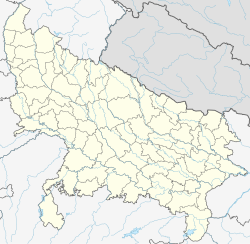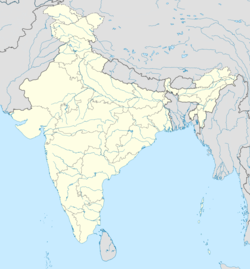Gorasara
This article needs additional citations for verification. (January 2021) |
This article may require copy editing for English grammar. (July 2021) |
Gorasara गोरसरा is a village in Kamsaar in the Indian state of Uttar Pradesh.[1]
Gorasara
Gorasara | |
|---|---|
village | |
| File:Gorasara Kamsar.jpeg | |
| Coordinates: 25°26′N 83°44′E / 25.43°N 83.74°ECoordinates: 25°26′N 83°44′E / 25.43°N 83.74°E | |
| Country | |
| State | Uttar Pradesh |
| District | Ghazipur |
| Established | 1655 |
| Founded by | Zamindar Bhikham Khan alias Feqan Khan |
| Government | |
| • Body | Gram panchayat |
| Area | |
| • Total | 397.96 ha (983.38 acres) |
| • Land | 380.227 ha (939.561 acres) |
| • Water | 17.733 ha (43.819 acres) |
| Population (2011) | |
| • Total | 4,684 |
| • Density | 1,200/km2 (3,000/sq mi) |
| Languages | |
| • Official | Hindi |
| Time zone | UTC+5:30 (IST) |
| Vehicle registration | UP |
| Website | up |
Gorasara village was established by Zamindar Bhikham Khan Urf Feqan khan in 1650 AD, who was the grandson of Sarkar Diwan Kutlu Khan Zamindar Jagirdar Taluka Sewarai. Kutlu Khan was a great-grandson of Narhar Khan, founder of Dildarnagar Kamsar.
According to some old records and sources in the village, Mughal minister came to this place during the rule of the Mughal emperor Shahjahan rule and witnessed that all the people living in the village had white skin, which led to its name Goresara, A village of white people, later during the British rule due to wrong pronunciation the name was changed to Goresara. As of 2011 census the main population of the village lived in an area of 87.5 acres of land with 637 households.[2]
AgricultureEdit
The soil of the village is rich in minerals.[3] The water level of the village is not more than 100 feet deep. The village land extends to the banks of Karmansa river. As of the 2011 census, the area of the village is 983.38 acres. Mango and other tree farms cover 162 acres of land and ponds cover 18 acres, with the rest of the land dedicated to other crop production. Many types of crops that grow in the nearby Ghazipur and Buxar districts are grown in the village.[4]
Gorsarsa has been known for its sunflower farming for more than 300 years. During the summer, sunflowers are planted on a large scale in the village, usually on more than 500 acres of land. Flowers are sent to other cities, states and countries. Sunflowers were used to make sunflower oil in the village during the Mughal and British rule eras. Rose farming is also done on a large scale. The village is known for its rose plantation done every year. The rose plantation is mainly done to make Rose water. Rosewater is very famous in the Ghazipur District and Rose plationton is done on a large scale in Kamsaar and Ghazipur. Every year various breeds of sunflower and rose are planted on a large scale in the village.[5]
PlantationEdit
When Goarasar village was established by Bhikham Khan alias Feqan Khan his son name as Zamindar Fateh Bahadur Khan build a large orchard in the village which was named Hazara Bagh or Hazar Pedh Bagh. The orchard built by Fateh Bahadur Khan was spread over an area of 300 Bigha and had more than 9100 trees. Now the orchard is small with an area of almost 120 Bigha and is owned by the family of Fateh Bahadur Khan as of 2015.[5]
InfrastructureEdit
As of 2011, the village had four mosques, three temples, two schools, three madrasa, one post office and many shops. Basheer khan mahila Mahavidyalaya is the nearest degree college to Gorasara, which is 5.8 kilometers away. Other area degree colleges include S.K.B.M degree college, which is 8.1 kilometers away, and Maa khamakya degree college, which is 13 kilometers away.
LanguageEdit
Bhojpuri is the local language.Template:Dildarnagar Kamsar
Histrorical PopulationEdit
| Population Growth of Dildarnagar Kamsar | |||
|---|---|---|---|
| Census | Population | %± | |
| 1861 | 1,205 | — | |
| 1871 | 1,446 | 20.0% | |
| 1881 | 1,807 | 25.0% | |
| 1891 | 2,170 | 20.1% | |
| 1901 | 2,495 | 15.0% | |
| 1911 | 2,994 | 20.0% | |
| 1921 | 3,743 | 25.0% | |
| 1931 | 4,117 | 10.0% | |
| 1941 | 4,325 | 5.1% | |
| 1951 | 4,303 | −0.5% | |
| 1961 | 4,098 | −4.8% | |
| 1971 | 3,884 | −5.2% | |
| 1981 | 4,200 | 8.1% | |
| 1991 | 4,372 | 4.1% | |
| 2001 | 4,500 | 2.9% | |
| 2011 | 4,684 | 4.1% | |
| Source:Census of India[6][7][8] | |||
ReferencesEdit
- ↑ "Bhulekh".
{{cite web}}: CS1 maint: url-status (link) - ↑ "Bhulekh".
{{cite web}}: CS1 maint: url-status (link) - ↑ http://lsi.gov.in:8081/jspui/bitstream/123456789/893/1/20460_1951_GHA.pdf
- ↑ "Evolution and Spatial organisation of clan settlements in middle ganga valley".
{{cite web}}: CS1 maint: url-status (link) - ↑ 5.0 5.1 "Ghazipur Gazatteer".
{{cite web}}: CS1 maint: url-status (link) - ↑ "Census of India". mospi.gov.in. Archived from the original on 13 August 2008. Retrieved 23 June 2008.
- ↑ "2011 census of India".
- ↑ "Historical Census of India". Archived from the original on 17 February 2013. Retrieved 5 November 2015.

